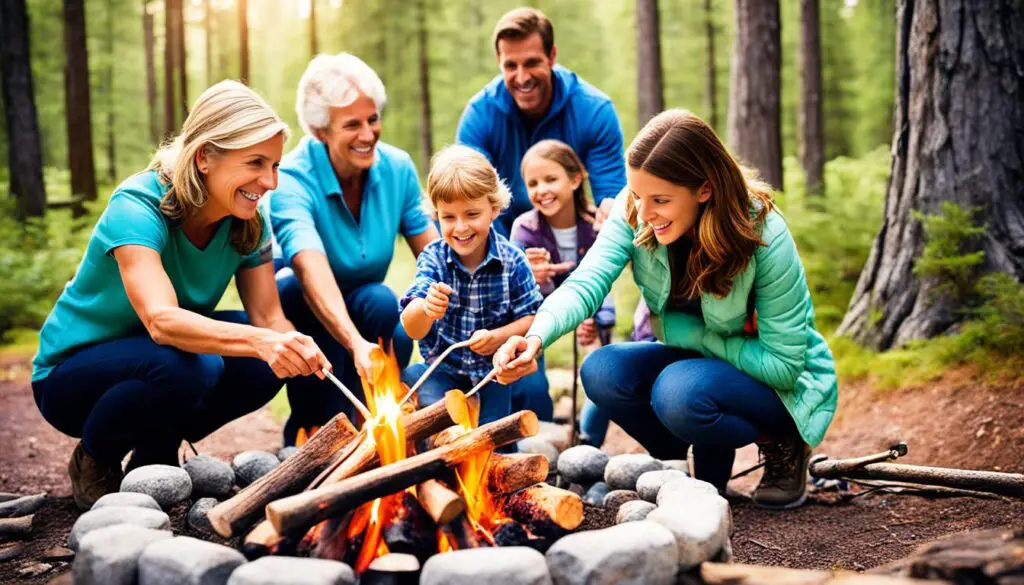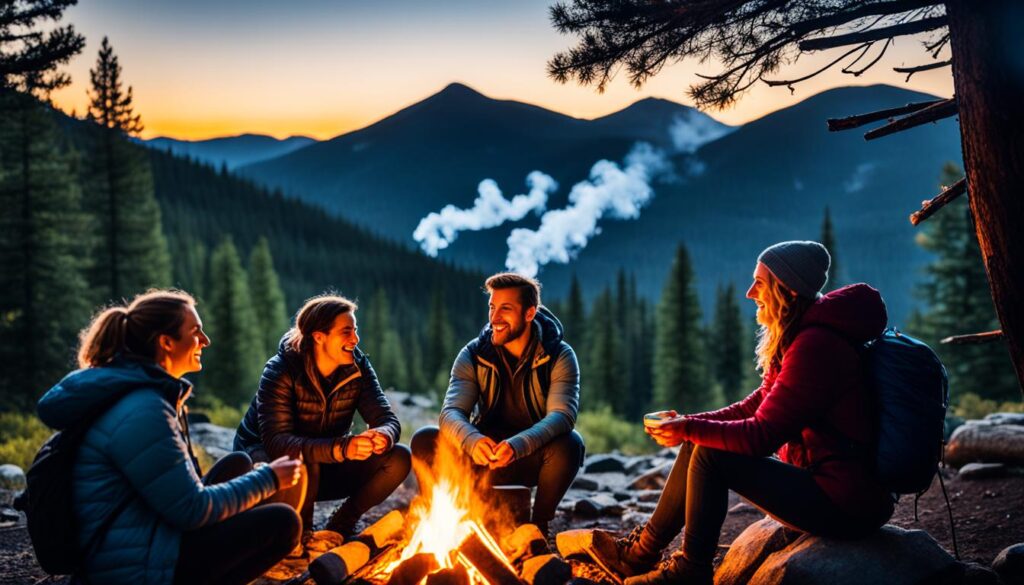What Is Frontcountry Camping
Frontcountry camping mixes adventure with convenience. It’s different from backcountry camping, which is deep in the wild. Frontcountry campsites are easy to get to by car or RV. This way, you can be close to nature and still have things like running water and electricity.
The frontcountry camping experience is perfect for those who like organized adventures. It’s great for car, RV, or van camping. These campsites offer many services. They’re ideal for families, groups, or people wanting nature with some home comforts.
Understanding Frontcountry Camping
Frontcountry camping is near developed areas and easy to reach. You can find campsites close to parks or forests. This lets you be close to nature but still have some modern comforts.
Defining the Frontcountry Experience
Frontcountry camping is all about being convenient and easy to get to. You can drive up to your campsite, so no long hikes are needed. This means you can bring more stuff to make your stay comfortable. Also, the campsites have things like restrooms, showers, and picnic areas to make camping fun.
Frontcountry vs. Backcountry Camping
Backcountry camping is different. It takes you deep into the wild with no developed areas around. You have to carry everything, and there are no restrooms or showers. But, it’s a chance to test your survival skills and experience nature like never before.
| Frontcountry Camping | Backcountry Camping |
|---|---|
| Proximity to developed areas and easy access | Remote wilderness areas with limited access |
| Campsites near state/national parks, national forests, or recreational sites | Campsites deep in remote wilderness, often miles from any infrastructure |
| Developed infrastructure, such as restrooms, showers, and picnic areas | No access to modern amenities or infrastructure |
| Ability to transport more gear and supplies | Backpacking and carrying all necessary equipment |
| Convenient and accessible camping experience | Primitive and self-sufficient camping experience |
It’s important to know the differences between frontcountry and backcountry camping. This helps you pick the right adventure. Whether you want easy camping near nature or a big wilderness challenge. Each choice makes your camping trip different and special.
Advantages of Frontcountry Camping
Frontcountry camping is perfect for new campers or those looking for a relaxed outdoor time. It’s easier to get to and has helpful amenities, making it a great choice for many.
These camps are near roads, making them great for families and people with walking challenges. Frontcountry camping lets you enjoy nature without a tiring walk.
Frontcountry sites often have restrooms, showers, and drinking water. They may also have electric hookups. This comfort is ideal for people wanting a cozy camping spot.
You can take more gear with you when frontcountry camping. Since it’s close to your car, you can bring extra clothes, cooking stuff, and fun gear like kayaks. This means you can have more fun while camping.
The many benefits of frontcountry camping appeal to a broad group. It suits both beginners and pros. Whether for an easy, well-equipped trip or a chance to bring lots of gear, frontcountry camping has lots to offer.

What Is Frontcountry Camping?
Characteristics of Frontcountry Campsites
Frontcountry camping offers a more developed and accessible camping experience. It is different from backcountry adventures. These campsites have well-maintained infrastructure and amenities for a comfortable outdoor stay.
Characteristics of frontcountry campsites include:
- Paved or gravel roads for simple entry
- Designated parking areas close to the campsites
- Established campsites with picnic tables and fire pits
- They have access to running water and electricity
- Flush toilets, showers, and camp stores for your comfort
The features of frontcountry camping areas make outdoor experiences more comfy and accessible. It’s great for families, first-time campers, or those who love amenities. At frontcountry campsites, visitors enjoy modern conveniences that meet their needs.
By knowing what to expect at frontcountry campsites, campers can better plan their trip. This helps them bring the right gear and have the best mindset for their camping adventure.
Planning Your Frontcountry Adventure
When you’re planning a frontcountry camping trip, think about the amenities the campground offers. You won’t need as much gear as you would for backcountry camping. But, packing the right items is key to having a great time.
Essential Gear for Frontcountry Camping
To enjoy your frontcountry camping adventure, take this recommended gear along:
- Tent – A dependable, weather-proof tent is essential, even for frontcountry trips.
- Sleeping Bag – Pick a sleeping bag that matches the expected campsite temperatures.
- Camp Stove – With a portable camp stove, you can cook meals and make hot drinks.
- Cooking Supplies – Bring a light cookset, utensils, and any pots, pans, or dishes you need.
- Outdoor Recreation Equipment – Don’t forget hiking boots, binoculars, or fishing rods to make your frontcountry camping better.
With a good plan and the right gear for frontcountry camping, you’ll have a comfy, fun frontcountry adventure.
Popular Frontcountry Camping Destinations
The United States holds many amazing places for frontcountry camping. It gives you easy ways to enjoy nature. You can visit places like Yellowstone National Park. It has incredible geothermal features. Or go to Yosemite National Park where you can see the big granite cliffs up close. These are just some of the many beautiful spots you can find.
Another favorite is the Great Smoky Mountains National Park. It’s on the border of Tennessee and North Carolina. You can enjoy lots of hiking, fishing, and seeing wild animals there. It also has comfy campsites and all the things you need.
If you love seeing mountains, clear lakes, or different kinds of nature, the U.S. has great frontcountry camping. These spots blend nature with comfort well. You get to be in the middle of nature but still have easy access to basic things. It makes camping a fun and easy way to explore the outdoors.
FAQ
What is frontcountry camping?
Frontcountry camping mixes outdoor fun with modern living. It’s different from backcountry camping. You don’t head deep into the wild. Instead, you camp in sites you can drive to. This means you can enjoy nature while still having things like water and power.
How does frontcountry camping differ from backcountry camping?
Frontcountry and backcountry camping are very different. First, frontcountry sites are close to cities and easy to reach by car. But backcountry camping means going far from roads, needing to be self-reliant. Second, at frontcountry places, you have water, power, and bathrooms. In the backcountry, you bring everything you need.
What are the advantages of frontcountry camping?
Frontcountry camping is great for those new to camping or wanting a cozy experience. Sites are usually near roads, making them easy to use. This is good for families or people with trouble walking. You also have things like bathrooms and showers nearby.
What can I expect at a frontcountry campsite?
Frontcountry sites are well set-up. They have roads and parking, so you don’t have to walk far with your stuff. You’ll find areas for tents, picnic tables, and fire pits. There’s also water and power. Some places even have showers and stores.
What should I pack for a frontcountry camping trip?
Think about what the campground has when you pack. Since you don’t need to carry everything, focus on the basics. Bring a tent, sleeping bag, and what you need to cook. Also, pack fun stuff like hiking gear or fishing poles.
Where are some popular frontcountry camping destinations?
The U.S. is full of amazing places for frontcountry camping. Yellowstone, Yosemite, and Great Smoky Mountains National Park are top picks. They offer beautiful nature, easy camping, and lots to do. Plus, you get modern comfort like showers and places to buy food.
